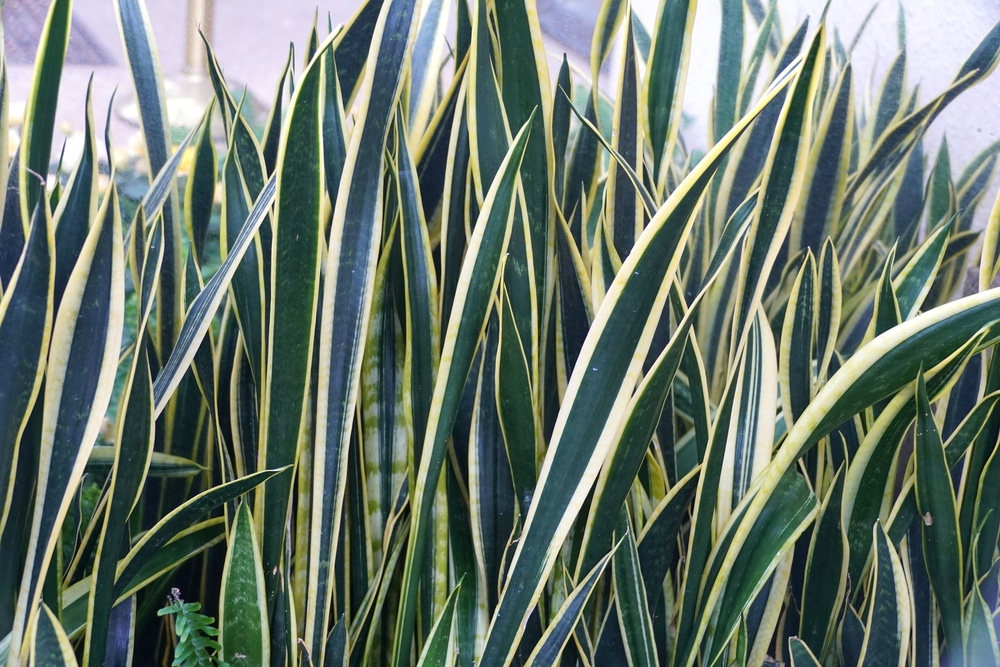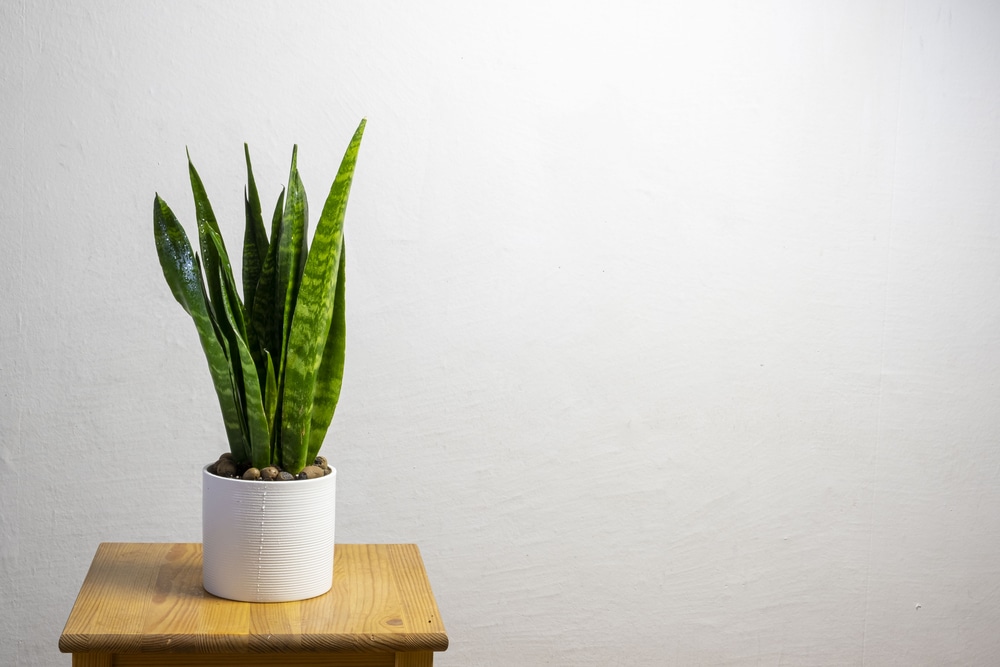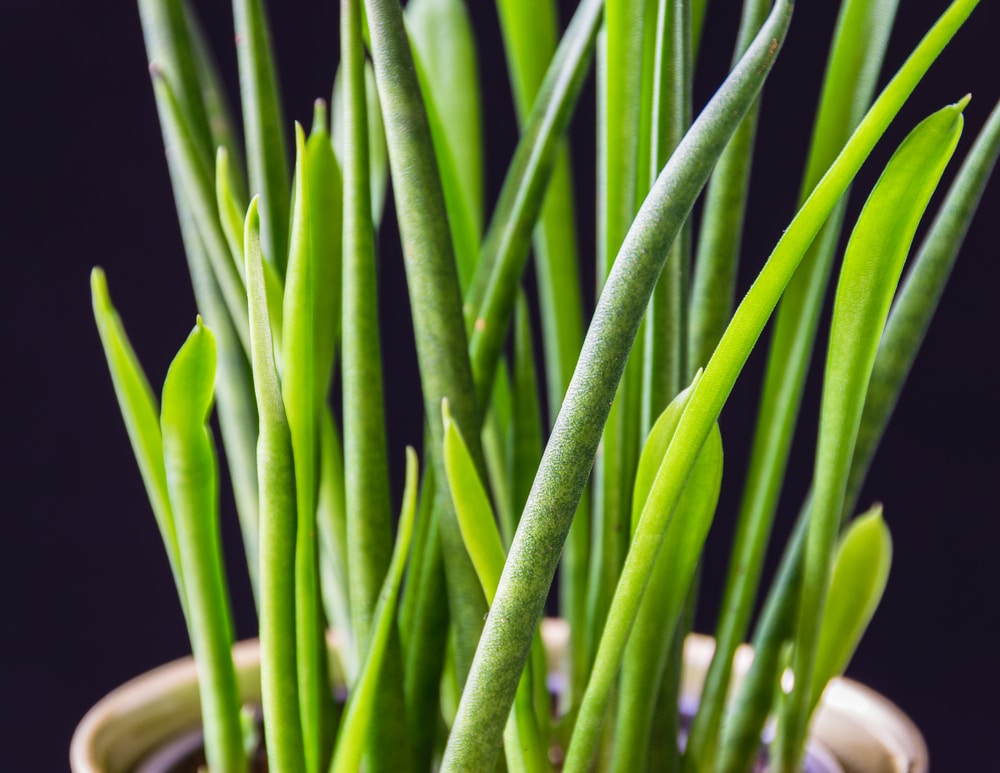Snake plants, sometimes incorrectly called Sansevieria, but more correctly classified as Dracaena trifasciata are a popular indoor plant because of their low light and water needs and general hardiness. Mother In Laws Tongue, as this plant is also commonly known comes in a multitude of different varieties and can compliment almost any indoor space, except for maybe a dark room.
These varieties have all either been selectively bread or found naturally and many of them are variegated in some way, which means they have less chlorophyll. In a typical plant, less chlorophyll produced means the plant needs more light, but snake plants have such low light needs that this is not an issue.
About Snake Plants
Snake plants also come in a variety of growth forms. This means the actual shape of the leaves is different. These varieties can range from short and stout to long and lanky, some even are cylindrical! Luckily these growth forms have no difference in care compared to the normal form, and so you are free to choose whatever form you think will compliment your home the best.
Snake plants are easy to propagate too! Once you have one plant you will have many little propagates, as long as you are willing to wait a little bit of time. The one caveat is that some different growth forms may revert to a normal growth form when propagated, but that’s okay because even “normal” looking snake plants can be showstoppers in their own right.
Our Favorite Snake Plant Varieties
Here are a few of our favorite snake plant varieties that you can keep at home:
Laurentii

Starting out with a bang, the laurentii snake plant is one of the most popular varieties and has even won the Royal Horticultural Society’s Award of Garden Merit. This basically means it is both incredibly popular, and robust which means it is a surefire winner for you. These are the classic variegated snake plants you can find in garden shops, hardware stores, and more! The broad flat leaves have a delicate stripe of yellow encapsulating them which gives them a unique look when paired with dark green plants.
Black Gold

Similar but not quite the same as Laurentii, Black gold has the distinctive yellow stripe on its wide slightly curved flat leaves. The center of Black Gold leaves are more dark, nearly black in some light, and that’s where it gets its name!
Futura Robusta
Many may lament the lack of a truly monochrome plant, but Futura Robusta, is about as close as you can get. The outer leaves are draped in a dark stripe of nearly black green and there are similarly colored horizontal stripes on the inside. Around these dark stripes is a background of light greyish green which looks lovely next to stainless steel appliances or in a neutrally colored room where you simply want a complimentary plant, rather than a big boisterous centerpiece.
Bantel’s Sensation
Another Royal Horticultural Society’s Award of Garden Merit winner, Bantel’s Sensation is a variety which has pale green or even white stripes around dark green stripes on their rounded flat leaves. These plants are a rare beauty in the houseplant trade, and everyone needs one to compliment their snake plant collection
Cylindrica

One of the most interesting growth forms on this list, cylindrica gets its name from the long pointy, almost cylindrical leaves t grows. These leaves resemble trunks, or perhaps green fingers reaching from the ground. These plants are a neat little oddball if you want a snake plant that people will always compliment.
Masoniana aka Whale Fin aka Shark Fin

This variety, which goes by many names, is one of the larger varieties of snake plants. This giant, wide, succulent leaves are sure to be a showstopper for anyone who sees them. One of the most popular ways to pot this variety is as a single leaf sticking out of the pot.
Gracilis
Very similar to Cylindrica in growth form, the variety Gracilis varies by having more of a centralized growth point that seems to branch out and looks like upside down tree roots. The leaves of this variety are also a lighter green ad are sometimes yellow green.
Moonshine

No, you can’t drink this variety of snake plant. These plants are named because of their shining green appearance that resembles the light from a moon. The entire silvery green flattened leaf resembles the background color of Futura Robusta, so if you want a more muted and lighter colored specimen plant then look no further.
Cleopatra
This growth form is one of the newest varieties to reach nurseries. This intricately pattered variety is really unique. The internal patterns on the leaves are dark green stripes surrounded by a lighter green that fades into different hues along the length of the leaf.
Ceylon Bowstring Hemp

One of the tallest varieties of snake plant, this plant will grow to nearly two and a half feet tall when given the right conditions and is a great way to fill vertical space!
Golden Hahni
The final Royal Horticultural Society’s Award of Garden Merit winner on this list, Golden Hahni is like is Laurentii and Bantel’s Sensation had a baby, but it stayed small forever! This dwarf variety stays short and squat with broad flat leaves that have a golden white hue to them. This variety is perfect for a small space of your plant collection that needs to be filled by something small, easy, and adorably cute.
Boncel

This is a variety of Cylindrica that originates from a central growth point but pans out and looks like a palm frond! The leaves on this variety are perfect to fill a large horizontal space without taking up too much depth.
Eilensis

Imagine a smooshed Boncel plant and that’s what you get with Eilensis! These plants only grow a few inches tall but fan out and sometimes the cylindrical leaves will drape over the sides of the pot. This plant is about as close to a trailing snake plant as you’re going to find.
Francisii

Resembling a Hawthoria succulent, this snake plant looks like if you stacked multiple Eilensis plants on top of each other. This spunky and spikey snake plant variety is possibly one of the cutest plants you can add to your collection.
Twist
Possibly the curviest and twistiest little snake plant pal, the twist variety is anything but ordinary! Light yellow borders a light green on this twisted little plant. It won’t stay little for long though; these plants can grow into beasts at 2-3 feet high and as many feet wide.
Liberica

This joyous jade hued snake plant is a short and stout with wide short leaves. This is an ideal plant if you want a shorter plant with a unique almost blue hue then the Liberica snake plant might be the plant just for you.
Whale fin Variegated
Very similar in form to the whale or snake fin, the variegated version has more creamy hues with a medium green border. The size, shape, and color of this variety is sure to be a standout.
Coppertone
This snake plant loves to soak up the sun, and it shows in the bronzy undertones. Lucky for you, you don’t need to take this plant to the tanning salon to get the perfect hue, it grows it all on its own. The initially compact plant can grow to have 4-foot-long leaves so make sure you have “planty” of space for it to grow.
Banana
These plants have leaves that are shaped like, you guessed it, bananas! These bananas are far from ripe though as they have a moderate green color that looks more appealing as a decoration than a food.
Jade Marginata
If you love the cream colors of the variegated plants but also love the deep jade colors of others, this variety is perfect for you. Jade Marginata also only grows to around 6 to 10 inches tall and so can fit in any space you have. If you need to fill more space, you could just buy one and then propagate it out to fill as much space as you want.
Longiflora
As the name implies, this variety is very long. Although the colors and patterns are muted and understated, the sheer size of this plant is not. These plants can grow 5 plus feet tall and would be ideal as a floor plant in any house, and it will nearly look you in the ye. Longiflora snake plants are an ideal specimen or statement piece no matter if you have 2 plants or 200.
Bacularis

Similar to Longiflora and Cylindrica combined, Bacularis is another tall statement piece for any house, especially if you want something out of the ordinary. These plants can reach 5 feet tall, although they often max out around 4 feet. They look like long green spike protruding from a pot and have the potential to take out an eye if you fall onto it, so be careful!
Basic Snake Plant Care
Snake plants are popular for two reasons. We’ve already discussed the first reason: they’re stunning and come in a variety of colors, patterns, and sizes! The second reason is they are ridiculously easy to care for. As long as you follow a few key principles, you can’t go wrong with their care.
Water
When watering, you want to be able to give the snake plant plenty of water and let the roots soak it up. Try not to water your snake plant unless the top inch or two of soil is dry, you don’t want your prized possession to succumb to root rot. Additionally, snake plants should be in pots with a good drainage hole to allow water to flow right through.
Light
Snake plants are very tolerant of multiple light levels and so you can have them in a variety of settings. The one caveat is they prefer brighter light, and so will show better colors in brighter light. If you have your snake plant in bright light make sure to also water, it more as it will be using more water throughout the day.
Temperature
This is not an outdoors plant if where you live gets chilly, even below 45 degrees or so. As long as you don’t allow the plant to be subjected to these cold temperatures you should not have an issue at all.
Fertilizer
Again, this plant is versatile! You can fertilize if you want, and it will allow your plant to grow better, but these are such slow growing plants you may not even notice it. I personally like to use sow release pellets in my potting soil for snake plants because it makes it easy to fertilize! Just replace them every few months and your snake plant will be happy as can be!
